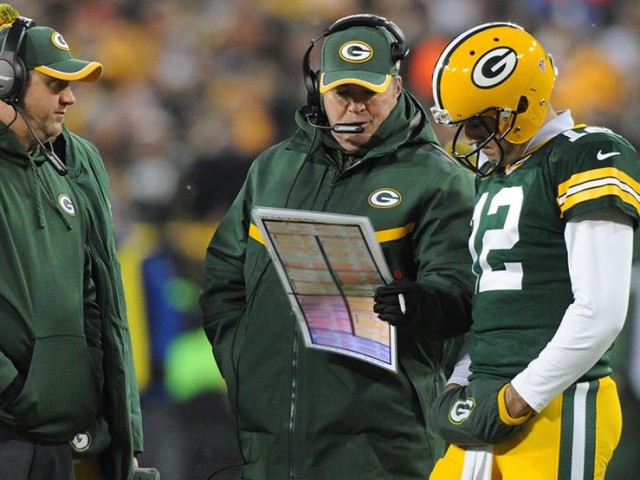
Photo credit: @Packers Twitter Account
On Sunday, the Green Bay Packers beat the Detroit Lions 30-20, and by doing so, won the NFC North Division and earned a first-round playoff bye.
Beating Detroit was no small feat because the Lions have a top defense, especially their front seven.
To beat such a formidable defense, the offense must have flexibility at the line of scrimmage to make sure they get out of a bad play call and get into a more favorable one.
There are several ways the offense can get out of a bad look and into a better one, including:
- Audible. The quarterback changes the play call at the line of scrimmage. This is a pre-snap adjustment.
- Multiple play calls in the huddle. The quarterback calls multiple plays while in the huddle and then gives a signal at the line of scrimmage to indicate which play is on. This is a pre-snap adjustment.
- Sideline play call. While rare in the NFL, this technique is common in college. The offense comes to the line of scrimmage without a play call, and once the defense is aligned, the offensive coach sends a signal to the entire team indicating which play to run. This is a pre-snap adjustment.
- Packaged play. The play design has two (or more) play run/pass options built into it. After the snap of the ball, the quarterback surveys the defense and quickly decides which option to run. This is a post-snap, in-play sight adjustment designed to exploit a weakness in the defensive play call.
For this article, we’ll look at a packaged play the Packers used against the Lions to gain a 1st down and keep the chains moving.
Pre-Snap Situation
- 3rd down and 1 yard to go from minus 45.
- Down and distance suggests run.
- Packers are in 11 personnel (1 RB, 1 TE, 3WR) and in gun. WRs are in plus splits (3 yards outside numbers).
- Lions are in nickel (5 DBs) and show initially a cover 2 shell (may be a cover 4 look; it’s tough to tell because defenses disguise their coverages pre-snap). They have one linebacker in a gap at the line of scrimmage who may or may not blitz. The combination of that linebacker and cover 2 is an incongruent coverage disguise; teams usually do not blitz under a cover 2 shell.
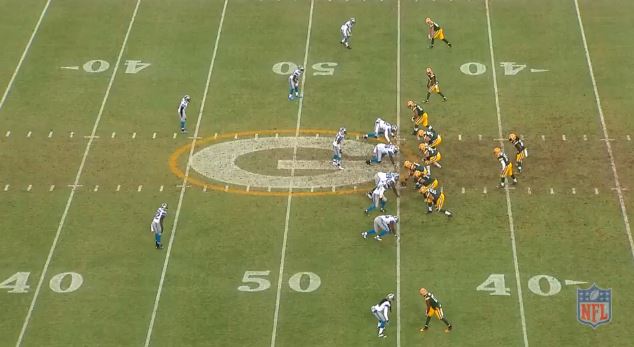
The Packaged Play
- Offensive line run blocks no matter what. They are blocking in a zone scheme.
- The running back should be on alert to receive hand off for an inside zone.
- All other eligible receivers (1 TE, 3 WR) run routes beyond the line to gain. The field receivers run stop routes and the boundary receiver runs a deeper pattern.
Post-Snap Keys
- If the defense plays off for the pass, hand the ball of the running back.
- If the defense plays downhill for the run, throw the ball to the nearest (most inside) open receiver.
- The decision must be made in less than 1 second.
The photo below shows the defensive scheme about a half of second after the snap. By this point, the defense has committed to their call. Their pre-snap look of cover 2 was a bluff. They are blitzing one linebacker, which means they are sending a total of five rushers to the line of scrimmage. Since this is a blitz, the pass coverage is man-to-man with a single-high safety (boundary side).
At this split second, look at the quarterback and running back at the 40 yard line, which is the mesh point. Aaron Rodgers’ eyes are down field surveying the defense. If he tucks the ball into Lacy’s gut, it’s a run play. If he pulls it out, it’s a pass play. That’s the package. While it may look like a play action, it’s not really; it’s a package because the running back may actually receive the ball.
The other linebacker, who was not blitzing, was reacting to run threat by the running back and filled the run gap between the hashes. The net effect is now there are six players at the line of scrimmage with four players back playing man-to-man coverage with a single-high safety. This linebacker is responsible for the running back in pass coverage (if the running back runs a route).
Since it is man-to-man coverage, and the cover 2 was a bluff, the field safety (wide side) is responsible for covering the tight end up the field hash mark. At this point, he’s 10 yards off the tight end. That is the key of the packaged play. The single-high boundary safety is playing over the top of the entire defense as the last line.
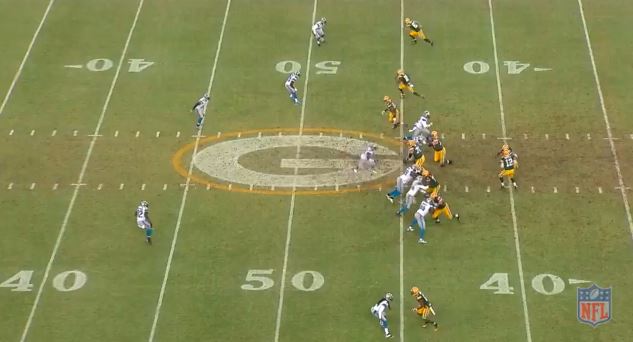
The Decision
The combination of six rushers and the soft coverage on the tight end dictated that the packaged play now options to the pass. The linebacker between the hash marks is in perfect position to stuff the run. The tight end’s nearest defender is 10 yards away and he is also the nearest open receiver. The tight end is the play target.
The Play in Slow-Motion
Let’s take a look at the play in action. The GIF below shows the entire play. Even in slow motion, it shows the quick decision making of Aaron Rodgers. Notice how the field side receivers all run short stop routes, the offensive line is zone run blocking, and the quarterback and running back mesh at the 40 yard line. Also notice both linebackers are at the line of scrimmage, which means the field safety is responsible for covering the tight end, who at this point is out of position. With a quick flip of the wrist, the Packers gain a 1st down by optioning out of an unfavorable run play into a highly favorable pass play. You can also see the boundary safety rotate over to the middle of the field for the single-high look.
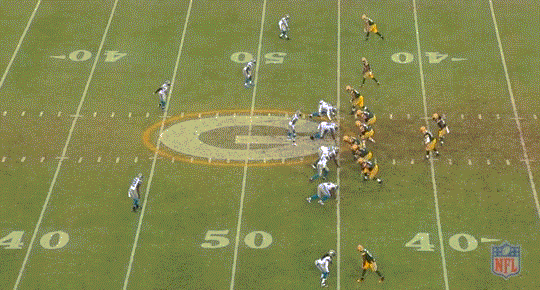
View from the End Zone
From this angle, you can see exactly what Aaron Rodgers sees. The Lions are showing a cover 2, which means the tight end (89) should be a hot read. The linebacker may blitz, which means the run is unfavorable. The offensive line is zone run blocking and the running back (27) takes an initial step as if the play is the inside zone. Rather than handing the ball to the running back, Rodgers quickly throws it to the wide open tight end, which was the correct read in the package. If the ball was thrown more to the inside, the tight end may have gained a few more yards, but we’ll not discuss that now.
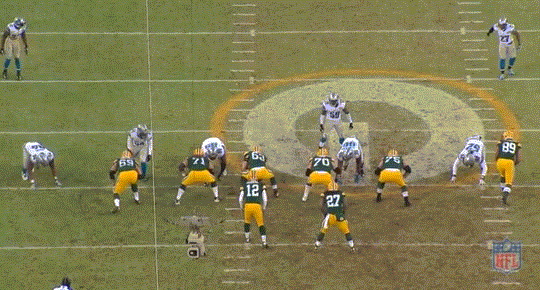
I believe the GIFs embedded above to be fair use under the premise of being short clips of the original broadcast that are transformative for news reporting, commentary, critique, illustration, and teaching purposes.
——————
Jay Hodgson is an independent sports blogger writing for AllGreenBayPackers.com and WISports.com.
——————

Impressive write up and very detailed.
Nice work Jay. I really like Richard Rodgers. He uses his body to shield the catch and has sure hands. I also like that ARod is looking his way. Looking for more good things from the Rodger twins.
Nice article…..I would say that Lacy would have easily made the first down even if AR decided to give him the ball. look at the great blocks we get on the play up front
It does look like Lacy would have had plenty of room to run, though I guess those are the chances you take.
Of all of AR’s considerable attributes to play the QB position at the very highest level, the processing power and speed of his punkin’ is #1.
Thanks, Jay. Nicely done and very informative.
You bring us more great knowledge every week, Jay. Two questions:
1) Are read-option plays, then, simply a form of packaged plays?
2) Do the Packers run packaged plays with the screen concept included? If so, could this be why they actually call more screens than we think they do?
Thanks. The answer to your question could be splitting semantic hairs. A packaged play means it has a run/pass option. Your regular read options are running plays with multiple options. There are some triple read options with two runs and a packaged pass that Auburn, Texas A&M, and the Seattle Seahawks run sometimes.
As far as the screen option, I’d say no due to how screens are blocked. The package is predicated on run blocking.
X’s and O’s means hugs and kisses right?
This is off topic, but I was jus thinking how great our D would have been if TT didn’t overthink the 2011 draft and pick Sherrod instead of Justin Houston. I just knew we were going to take him in that draft.
If this is an indication of Richard Rodgers improving, I don’t need to remind everyone of just what kind of difference that will make in the playoffs. In almost every loss we had, Cobb and Nelson were essentially shut-out of the game, hence the need for some other receiver or TE to step up. If this happens against Seattle, the game could literally fall on whether or not he plays well. If not, then a shut-out of the Seahacks may be our only chance to win that game. GET WELL FAST AARON! GO PACK!!!
I agree Chad. We need a no. 3 to step up and play like a veteran. The entire season now comes down to either Davante Adams or Richard Rodgers being able to play like a veteran, make every single catch, run every route properly and not f up. My money right now is on Richard Rodgers. If both Adams and Rodgers step up, then we should be unstoppable unless Rodger’s calf gives out.
Ted
Boykin was the guy that blew the Detroit punt after the safety. If you look carefully, he was closest to the ball and just watched the ball drop and did nothing.
I’m still saying bring up Jeff Janis.
I believe you Montana. You talk about one of the most disappointing players on the roster it’s Boykin. I was pissed at Boykin’s lack of effort on that Buffalo kickoff return. He just looked like he didn’t give a shit trying to bring the guy down.
It would be nice, but can we expect to get anything out of this guy receiver wise in the playoffs? Either he’s depressed or totally pissed off for reasons unknown. Either way he’s been a huge disappointment after most projected him to continue to ascend.
Even if you throw him in the rookie group my money is still on Richard Rodgers. He seems the most mature and ready out of all to make a positive impact the next few weeks.
Ted
You already got praise for your work and that is well deserved. But I can not tell how much this is helpful for me to better understand all of beauty of the football, so thank you very much again…
Happy New Year to you, Croat. You are a really decent human being.
Happy New Year to all Packer Nation. Amongst other wishes for you, I wish for all of us SB victory this season!
Thank you for kind words Savage…
Thanks, I’m glad you like these.
Dear Jay, When MM calls in the play to Rodgers, what sort of thing is MM likely saying to Rodgers? I mean, does he call just one play (even if said play has a pass/run or other options built-in)? Does he call multiple plays and lets AR decide? Is there a way to know?
That’s a great question and I don’t have a definitive answer for you. Based on what I know about other teams, I suspect the Packers:
1) Install several audibles in their game plan each week. They are assigned a hot word, and Rodgers calls it when he wants it.
2) There is probably at least one hot pass play always ready to audible to automatically switch to for every run play. Likewise, there is probably always one hot run play to switch to for every pass play.
3) Play callers frequently send in two plays to the huddle all the time and tell the QB to kill one at the line. Also, if they go up tempo, the other play is automatically run the next snap.
4) I’m fairly certain that no matter what is sent into Rodgers, he has the final call at the line of scrimmage to run it or switch out of it.